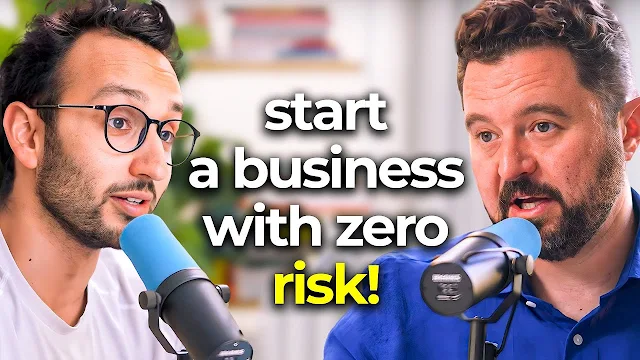Guest: Daniel Priestly
Serial entrepreneur, author, and keynote speaker.
Has built multiple $10 million+ businesses.
Known for applying practical business frameworks and tools for growth.
Host: Ali Abdaal
Key Takeaways:
Entrepreneurial Growth Stages: The podcast explores the journey of an entrepreneur from $0 to $10K per month, then from $10K to $100K, and finally from $100K to $1M per month. Each stage requires different strategies, frameworks, and mindsets.
Framework for Business Growth:
Product Types: Discussion of the four different types of products and the "Eiffel Tower" metaphor, explaining how these products stack to support business scalability.
CHAOS Framework: A strategic approach consisting of Concept, Audience, Offer, and Sales to guide new entrepreneurs from idea to execution.
Misconceptions about Entrepreneurship: Addressing myths that entrepreneurship is unpredictable and risky by comparing it to building with LEGO—following step-by-step instructions can make it manageable and less daunting.
Importance of Origin, Mission, and Vision: Entrepreneurs should connect their business idea to a personal story or passion to create a meaningful and sustainable venture.
Sales vs. Volume-Based Businesses: Emphasizes why beginners should focus on high-ticket, low-volume sales businesses over low-ticket, high-volume ones, which often require significant upfront investments and have higher failure rates.
Podcasts Notes:
1. Understanding the Entrepreneurial Journey:
Stage 1: $0 to $10K per Month:
Key Strategy: Focus on selling high-ticket items or services that bring in at least $2K per sale.
Example: Offering consulting services or packages with a clear value proposition.
Stage 2: $10K to $100K per Month:
Key Strategy: Develop and scale systems to handle more clients and maintain service quality.
Importance of building a team and delegating tasks effectively.
Stage 3: $100K to $1M per Month:
Key Strategy: Focus on optimizing processes, refining product-market fit, and scaling operations.
Explore different revenue streams, including product expansion or international market entry.
2. Frameworks and Strategies:
The CHAOS Framework:
Concept: Start with a strong business idea linked to a personal origin story or passion.
Audience: Identify and engage a specific target market through events, quizzes, and online communities (e.g., WhatsApp groups).
Offer: Create a compelling offer that addresses the needs of the target audience. The offer should be clear, valuable, and ideally priced above $1,000.
Sales: Develop a sales process that is professional, consultative, and focused on solving problems for the client. Conduct at least 30 one-on-one sales meetings to gather feedback and refine the offer.
3. Debunking Misconceptions about Entrepreneurship:
Comparison with Trading:
Trading is a zero-sum game with clear winners and losers, whereas entrepreneurship allows for value creation and differentiation in the market.
Entrepreneurship involves identifying unmet needs and solving them innovatively.
Entrepreneurship vs. Traditional Employment:
The traditional education system prepares individuals for "component labor" roles, while entrepreneurship requires a broader, more creative approach to solving problems.
4. Defining Your Business Concept:
Link to Origin Story:
Connect the business idea to a personal experience or passion. For example, the host shares a story about learning to code and creating websites as a child, which later influenced his entrepreneurial path.
Importance of aligning business goals with personal values to maintain motivation and drive.
5. Sales vs. Volume Businesses:
Sales Business (High-Ticket, Low-Volume):
Examples: Consulting, coaching, specialized services (e.g., web development, content creation).
Advantages: Higher profit margins, easier to scale initially with fewer clients.
Volume Business (Low-Ticket, High-Volume):
Examples: Apps, consumer products, low-cost services.
Disadvantages: Requires significant upfront investment, longer time to profitability, higher risk of failure.
6. Practical Tips for New Entrepreneurs:
Test Ideas with Minimal Investment:
Conduct small tests like webinars, quizzes, and community groups to validate the business concept.
Use feedback from these tests to refine the offer and sales approach.
Focus on Building Relationships and Trust:
Start with direct engagement with potential clients to understand their needs and preferences.
Gradually scale up once you have a proven concept and a repeatable sales process.
7. Additional Insights:
Organizing Force: The entrepreneur’s primary role is to organize resources, not necessarily to perform every task themselves. Focus on building a team that complements your skills.
Mindset Shift: Move from a "doing" mindset to an "organizing" mindset to scale effectively.


